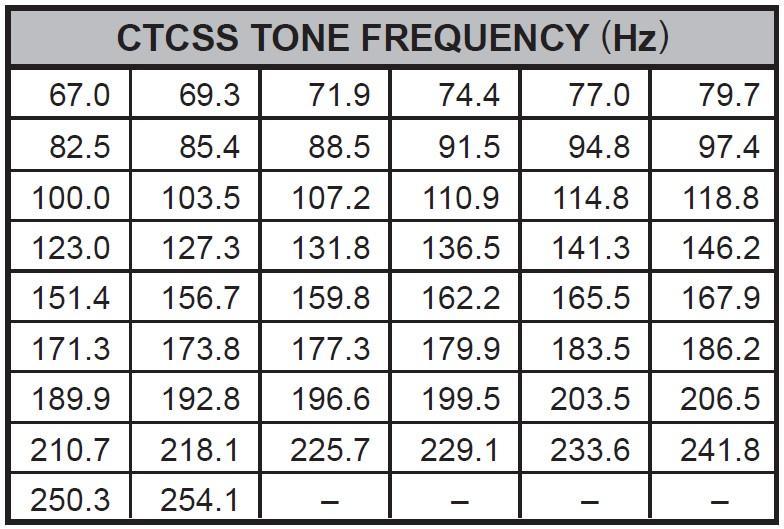 Although not too many hams seem to have been aware of it, for several years now repeater councils of many Midwestern states (including the Indiana Repeater Council) have been on a course to require that ALL coordinated repeater systems on all VHF and UHF bands require a CTCSS tone be present on the input to the repeater in order for the repeater to un-squelch and retransmit the received audio.
Although not too many hams seem to have been aware of it, for several years now repeater councils of many Midwestern states (including the Indiana Repeater Council) have been on a course to require that ALL coordinated repeater systems on all VHF and UHF bands require a CTCSS tone be present on the input to the repeater in order for the repeater to un-squelch and retransmit the received audio.
CTCSS, stands for continuous tone-coded squelch system, often called “tone” or “PL” (i.e. “Private Line,” a Motorola trademark); it is a sub-audible frequency between 67.0 Hz and 254.1 Hz that is added to the audio of the signal that is transmitted to the input of a repeater. In other words, the handheld, base station or mobile rig that is intended to operate through the repeater must have a CTCSS tone encoder installed in it. (Virtually all post-1980 built amateur FM transceivers have the capability built-in.) Detection of the sub-audible tone then satisfies the condition necessary to un-squelch the repeater receiver and cause the detected audio to be retransmitted. Often, the repeater also will transmit the same tone on its output, so that individual receivers, so equipped for CTCSS, will only un-squelch for the local repeater and not be bothered by occasional DX repeaters, spurious signals, noise and so forth.
This move is significant to anyone that operates a repeater system, since coordination is essentially mandatory. Although the FCC does not explicitly require that a repeater be coordinated, it does however always stand behind the coordinated machine if any kind of complaint is received. By virtue of this, if you do not have the blessing of the recognized coordinating body in your state, it is only a matter of time before you’re off the air! This implies that anyone with a current coordinated repeater pair could lose that status and another party could potentially “hijack” the frequency! We would hope that this could never happen, but it pays to be prepared.
It should be noted that the councils are actively trying to find so-called “paper repeaters” and take away their coordination. A paper repeater is a where you have an assigned frequency to an individual or club, but the machine never was put on the air, thus potentially denying a bona fide repeater from getting a frequency.
All new systems are now required to have CTCSS, or they won’t be granted coordination. Existing systems have, we believe, a two-year grace period to establish CTCSS operation. This is true of all our surrounding states’ repeater councils as well, so Illinois, Wisconsin, Michigan, Ohio and Kentucky machines will be required to go CTCSS as well. If you look in the repeater directory you will see that about 70 percent of the nation’s repeaters have this, too. It will apply to 50, 144, 222, 440, 902 and 1,296 MHz repeaters.
Interestingly, one of the main arguments that the councils make for requiring CTCSS is for emergency operation! Their opinion is that no one scans repeaters anymore since noise so frequently opens up the machines, and “captures” the scanner thus effectively reducing the amount of area repeater monitoring that goes on. They believe that requiring tone will, by virtue of scanning, increase the amount of monitoring that occurs, thereby improving the chances that someone hears and responds to an emergency call.
Think of it this way: Someone from out of the area who wants to make a call must look up the local repeaters, since they have no way of knowing what the frequencies are or tone situation is. If we travel to somewhere we are unfamiliar with, we have to do the same. Locals already know the situation, so no problem.
To clear up one semantic point: an “open” repeater is one that is open to use by any amateur. It has nothing to do with whether or not that repeater requires tone. “Closed” machines are those that can only be accessed by hams belonging to a certain club or entity. Either system can be CTCSS or not.
Since the FM repeater is now the most prevalent entry route into amateur radio, it is important that all clubs maintain good, coordinated systems that all local hams can use.
We have up to two years to implement this switch to CTCSS operation, so it is my belief that the FWRC board of directors should undertake a study as to the most effective means of accomplishing this, and also study the operational issues of doing it, including the handful of operators with pre-1980 radios and if anything can or should be done to help. I am sure that this move will be controversial, but we want to maintain our repeaters at the highest level, as well as being good neighbors in the VHF/UHF environment. We will be publishing more as this move unfolds.
As always, your comments, suggestions, and opinions are important to us. If you have personal thoughts on this matter, please e-mail or call me. We do want to represent the best interest of the hams in the club.
